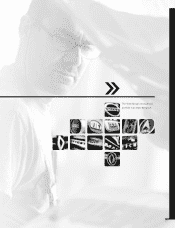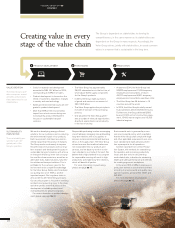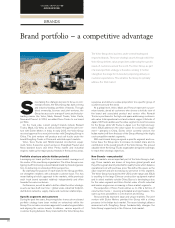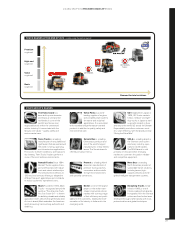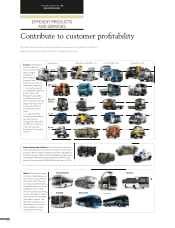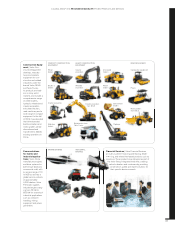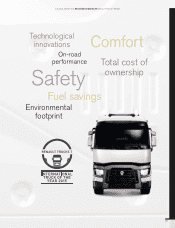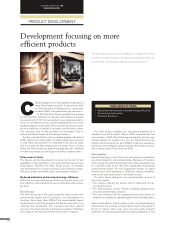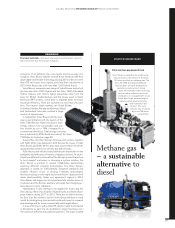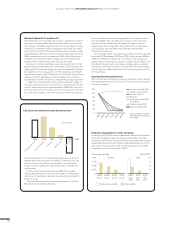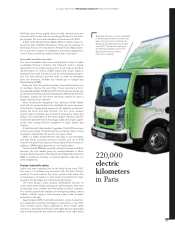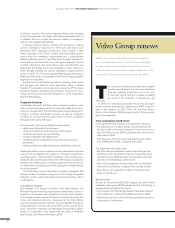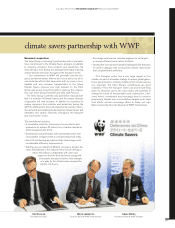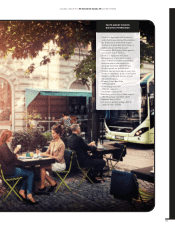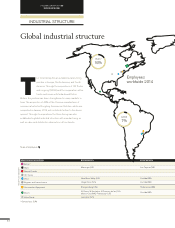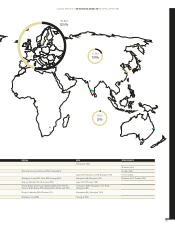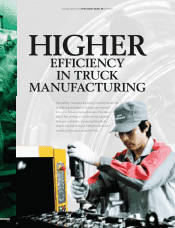Volvo 2014 Annual Report Download - page 40
Download and view the complete annual report
Please find page 40 of the 2014 Volvo annual report below. You can navigate through the pages in the report by either clicking on the pages listed below, or by using the keyword search tool below to find specific information within the annual report.
The Volvo Group’s future success depends on its ability to continue
to deliver innovative solutions and develop technologies that can
be converted into fi nancially viable products and services.
Climate change is one of the greatest challenges of
today. Road freight accounts for around one third
of world transport oil demand and is responsible
for about 4% of total greenhouse gas emissions.
In 2014 the Volvo Group operated from a strong
product portfolio following the Group’s most extensive product
renewal during 2013. The new products were developed with a
focus on fuel effi ciency and customer profi tability. As one of the
leading companies in the area of fuel economy, the Group is work-
ing on a multitude of solutions to increase fuel effi ciency, reduce
CO2 emissions and to offer drivelines for alternative fuels to
reduce the climate impact of the transport industry.
Another important factor is the escalating problem with lack of
traffi c safety in the world. Today 1.2 million people die every year
in road traffi c and by 2030 it is estimated to be twice as many,
and to become the fi fth leading cause of death. This is an area
where the Volvo Group has great knowledge and can contribute
to make our products as well as general traffi c situations safer.
Three areas of focus
The Group’s product development is driven by the cost of and
availability of fuel, legislation in the environmental area and new
technologies. Therefore, the Volvo Group focuses its research
and development on reduced emissions and increased energy -
effi ciency, product and traffi c safety and transport solutions.
Reduced emissions and increased energy-effi ciency
Within the emissions and energy effi ciency area, the focus is on
fuel effi ciency, electromobility as well as alternative and renewa-
ble fuels.
Fuel effi ciency
The Volvo Group has a life-cycle perspective and considers the
environmental impact from its products, from development to
recycling. Since more than 90% of the environmental impact
results from the use of the products, the Group's main focus is on
reducing fuel consumption, CO2 emissions and other exhaust
emissions. The basic principle is that each new product shall have
less impact on the environment than the product it replaces.
The Volvo Group estimates the fuel-saving potential for a
standard truck will be about 15% in 2025 compared with fuel
consumption in 2010. New technology can lead to even more sig-
nifi cant savings. For instance, the use of a hybrid driveline may
improve fuel consumption by up to 39% in certain bus operations.
If all buses were changed to plug-in hybrids, the energy consump-
tion could be reduced by as much as 60%.
Electromobility
Hybrid technology is one of the most promising and competitive
new technologies for commercial vehicles. Because of its poten-
tial for saving fuel, hybrid technology means lower operating costs
for customers while at the same time signifi cantly reducing the
environmental impact. The most appropriate vehicles for hybrid
drivelines are those operating in continuous stop-go conditions,
such as city buses and refuse or distribution trucks.
The Volvo Group strategy for bus electromobility consists of
three focus areas:
• The vehicles offering; the hybrid, electric hybrid and the up-
coming full electric.
• The total transport system offering; including charging infra-
structure and telematics solutions.
• The open interfaces for the charging infrastructure; where our
ambition is to establish a standard together with key stakeholders.
Sales of Volvo Buses’ hybrid models continue to pull ahead when
cities all over the world are working hard to improve the quality of
life for its citizens. That is why more and more public transport
authorities are imposing particularly far-reaching demands on low
Development focusing on more
effi cient products
A GLOBAL GROUP 2014
BUSINESS MODEL
PRODUCT DEVELOPMENT
THREE AREAS OF FOCUS
• Reduced emissions and increased energy-effi ciency
• Product and traffi c safety
• Transport Solutions
36



